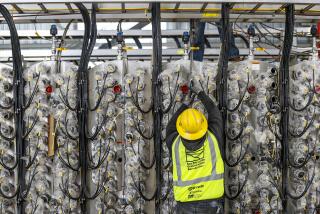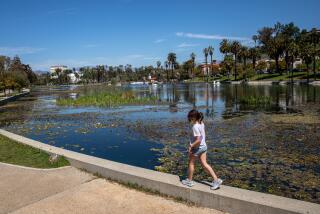Lockheed Offers to Give Burbank Its Cleaned-Up Ground Water
Lockheed Aeronautical Systems Co., under state orders to start cleaning up chemically tainted ground water beneath its Burbank plant by September, is talking with city officials about pumping the nearly 1.5 million gallons a day of treated water directly into the municipal supply.
State and federal environmental officials said they believe the arrangement, which would provide about 7% of Burbank’s yearly water needs, would be the first of its kind in California.
But Fred Lantz, water system manager for the Burbank Public Service Department, said a long list of technical and regulatory questions must be resolved before the city accepts the offer.
The free water could cut Burbank’s annual bill with the Metropolitan Water District by more than $300,000. But Lantz said the city will forgo this particular windfall if it isn’t certain that the arrangement will be safe.
If an agreement is reached, Burbank’s use of the water would still have to be approved by the state Department of Health Services, which regulates the qualilty of drinking water. Gary Yamamoto, district engineer for the agency in Los Angeles, said he was unaware of the proposal.
Cheap ground water from municipal wells could meet 20% of Burbank’s water needs, but the city’s 10 wells are shut down because of pollution, and Burbank is relying entirely on more expensive water from the Metropolitan Water District.
Lockheed Partly to Blame
The Burbank wells are a short distance from Lockheed, and the most prevalent pollutants in the wells are also found beneath Lockheed at much higher concentrations, leading officials to conclude that tank leaks and spills at Lockheed are at least partly to blame.
Water beneath the plant contains perchloroethylene (PCE) levels as high as 12,000 parts per billion, or p.p.b., and trichloroethylene (TCE) levels as high as 1,600 p.p.b., according to tests by Lockheed consultants. Both chemicals have been used for metal degreasing and dry-cleaning and are thought to cause cancer under conditions of chronic exposure. Under health guidelines, PCE and TCE levels in drinking water are not to exceed 4 p.p.b. and 5 p.p.b., respectively.
Under orders from the California Regional Water Quality Control Board, Lockheed is planning to start treating nearly 1.5 million gallons a day of polluted ground water, with a process using steam and aeration to bring PCE and TCE levels within health guidelines.
If Burbank does not take the water, Lockheed could get permits to reinject it into the ground or dump it into storm drains that would carry it to the Los Angeles River.
“There is no advantage to Lockheed” to give the water to the city, said Ross Hopkins, public affairs manager for the company. “I think it’s mostly a concern over the water not being wasted,” he said.
Reinjection Alternative
Reinjection “would be the alternative we would probably choose if we can’t work out a deal with Burbank.”
Lantz said that Burbank must be assured that, if Lockheed’s treatment plant failed, it could be isolated “from our system prior to having any waters that exceed the standards reach our customers.”
Besides a huge reduction in PCE and TCE levels, the treated water would have to meet standards for such other contaminants as heavy metals and nitrates, which in excessive amounts are believed to cause some infants to suffer an oxygen deficiency known as “blue baby syndrome.” Lantz said some ground-water samples at Lockheed showed excessive amounts of nitrates.
The water also would need treatment with chlorine or another disinfectant before being added to the municipal system. Lantz said an agreement would also have to be reached as to where the water would be delivered. A city water pipeline crossing Lockheed at Buena Vista Street, a few hundred feet from the company treatment plant, might serve as the connection.
“The ball, I think, is in their court with regard to some of the conditions,” Lantz said.
Hopkins said talks must be concluded quickly to meet the state’s Sept. 15 deadline for starting the treatment. “Right now, there’s no ‘drop dead’ date set,” Hopkins joked. But, “at that point when the water starts coming out, we sure hope we know what we’re going to do with it.”
$6-Million Study
By start-up of the treatment system, Lockheed will have spent about $6 million studying and trying to correct the ground-water problem, Hopkins said.
Even then, the company’s involvement may not be over. The federal Environmental Protection Agency has served notice on Lockheed that it might be held responsible for some costs of another treatment system that will be built for Burbank under the federal Superfund toxic cleanup program.
A long swath of the San Fernando Valley and neighboring Glendale has been designated as a Superfund site because of PCE and TCE contamination of wells serving Los Angeles, Burbank, Glendale and the Crescenta Valley County Water District.
As part of the Superfund cleanup, the EPA has tentatively approved construction of a ground-water treatment system at Burbank’s municipal wells--both to restore use of the wells and to slow the spread of pollution seeping toward wells of Los Angeles and Glendale.
Officials say a wide array of industries is responsible for the pollution. TCE was widely used by a variety of industries until the mid-1960s, and PCE is still used by many businesses to degrease metal and dry-clean clothes.
More to Read
Sign up for Essential California
The most important California stories and recommendations in your inbox every morning.
You may occasionally receive promotional content from the Los Angeles Times.










